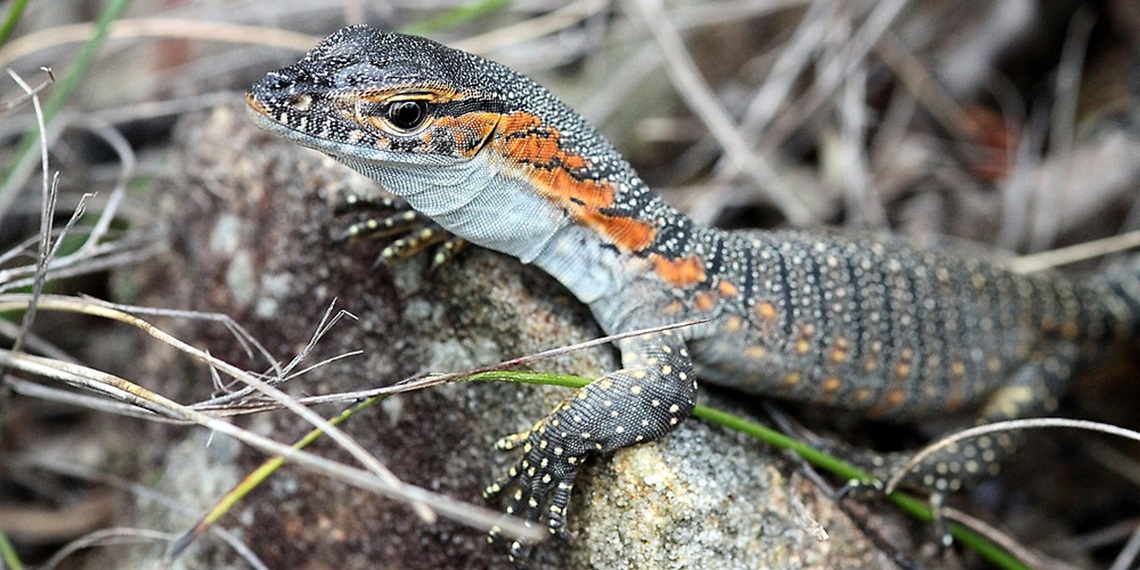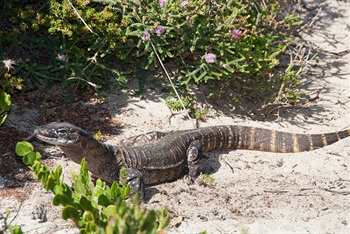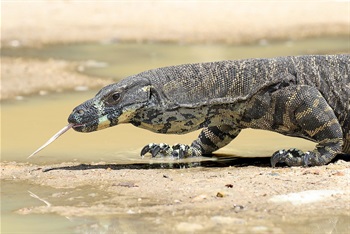Rosenberg's goanna

Appearance
Rosenberg's Goanna (Varanus rosenbergi) is a species of monitor which reaches up to 1.5 metres in length. Often confused for the more common Lace Monitor (Varanus varius), a distinguishing feature of this species is the pairs of narrow, regular bands extending the length of their tails and distinct, finely barred “lips” when compared to the broad barring found in Lace Monitors.
Distribution and habitat
It can be found within the Wollemi National Park to the north-west of Sydney, in the Goulburn and ACT regions and near Cooma in the south. There are records from the South West Slopes near Khancoban and Tooma River. They also occur in South Australia (Kangaroo Island) and Western Australia. They are generally found in heath, open forest and woodland areas, specifically in areas with terrestrial termite mounds, used as nesting sites for females. They have large home ranges, using caves, rock crevices and burrows for shelter. They will also use burrows of other animals such as rabbits.
Diet
Rosenberg Goannas are not picky with their food, happily eating birds, eggs, reptiles and small mammals. They will also readily eat carrion (already dead/decaying animals).
Breeding
A fascinating breeder, they lay up to 14 eggs into a termite mound, which are sealed into the chamber by either the termites or the female goanna. She will then guard the nest for 1 – 3 weeks, after which time the termite mound offers protection for the eggs. The young dig themselves out but will stay close and feed on the termites for several days. They will then use the mound as shelter in the coming months.
Conservation status
Listed as Vulnerable under the NSW Biodiversity Conservation Act 2016. This is due to habitat destruction and fragmentation, specifically the removal of terrestrial termite mounds (for nesting) and fallen timber (for shelter). They are also vulnerable to car strike due to their appetite for road kill and predation by cats, dogs and foxes.
Did you know?
- Goannas can live for up to 30 years.
- Unlike the Lace Monitor, which is known to scurry up trees when threatened, Rosenberg Goannas tend to remain on the ground.
- While generally day active, females tend to lay their eggs in the late afternoon and into the night. This is because termites will work more actively at night to close up the disturbance in the mound to ensure heat and humidity is not lost during the colder nights.
- Females expend so much energy in the breeding cycle that they will often have a 1 – 2 year break before breeding again.
- Reptiles are super-efficient eaters! Rosenberg Goannas on average will eat approximately 5 times their body weight each year, while a marsupial carnivore like an Eastern Quoll will eat up to 65 times its own weight.
The termite mound below is a perfect example of a nesting space for Rosenberg's Goanna.
Please note, these are NOT the same termites that can invade the timber in residential homes!
 |
 |
Rosenberg's Goanna
|
Lace Monitor
|